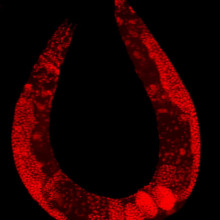In this NewsFlash, why the Pioneer anomaly is not so anomalous, how a dose of cortisol can cut fear of heights, and how a common dye used to colour cells in the lab may increase lifespan. Plus, in televised debates, how a biased "worm" can seriously skew the results.
In this episode

00:26 - The Pioneer Anomaly may not be anomalous
The Pioneer Anomaly may not be anomalous
The Pioneer Anomaly sounds like some kind of thriller novel, but is actually a slight accelleration on the Pioneer probes, these are space probes launched in the 1970s and now the most distant man made objects. As they headed away from the solar system their path was carefully tracked, and a strange anomoly was discovered, they were decellerating slightly faster than they should be according to einsteinian gravity.

(c) NASA
' alt='Pioneer 10 and Pioneer 11' >This effect was tiny, about 1 part in 10-10 ms-2 , but it was measurable, and it got lots of theoratitions very interested. This is because studies of galaxies indicate that gravity may be stronger at longer distances, so lots of theorists were creating new theories of gravity to fit the data.
In 2008 a third of the anomoly was explained by Frederico Francisco and collegues, the spacecraft generates power from heat produced by radioactive decay, this heat is lost by thermal radiation, which is a form of light. Light carries momentum, so can apply a force to the spacecraft. But they hadn't managed to explain the whole anomaly.
Now they think they have - a source of heat - the main electronics compartment is immediately behind the parabolic dish the spacecraft uses to communicate with earth. So thermal radiation from the electronics will reflect off the dish giving the spacecraft a slight extra decelleration, explaining very neatly the anomaly.
So unfortunately for the theorists and their chances of a Nobel prize, Einstein's equations still hold.

02:27 - Cortisol knocks height fear on the head
Cortisol knocks height fear on the head
Scientists have discovered that a dose of one of the body's own stress chemicals can neutralise a fear of heights.
Writing in PNAS, University of Basel researcher Dominique de Quervain and his colleagues recruited 40 patients with confirmed height phobia. The patients were divided an intervention group and a control group.
Over several days, both groups were then subjected to a series of three graded height exposure therapies using a virtual reality headset to fool the wearer into believing he or she was traversing a series of above-ground walkways and platforms.
While this was happening, the subjects were also asked to rate their subjective levels of discomfort, and skin conductance measurements, another measure of stress, were collected from some of the participants. The subjects paused at each "station" along the way until their self-reported stress levels fell.
Critically, prior to each of these three treatment sessions, the members of the intervention group also received a small oral dose of the chemical cortisol, one of the body's own stress hormones produced by the adrenal gland.
Following the treatment sessions, all of the subjects were then followed up with two assessments 3 days and 28 days later at which their levels of height phobia were reassessed.
The subjects all benefited from the exposure therapy, with the controls showing about a 30% reduction in fear responses during the later assessments. But amongst the cortisol-treated group, fear had fallen by over 60%.
The reason for this, the researchers argue, is that cortisol causes impaired recall of established memories whilst simultaneously strengthening the formation of new ones.
So by exposing the acrophobics to a stressful virtual height situation and permitting them to get used to the sensation at each stage, in the presence of cortisol, the subjects recalled fewer of their fear memories and re-wrote stronger imprints of the experience being less stressful, causing their fear responses to be "extinguished".
The team also point out that the method might be generalisable to other anxiety states too.

06:01 - Watching the Worm May Turn Voters
Watching the Worm May Turn Voters
Dr Colin Davis, Royal Holloway University of London
Chris - In last year's general election we had the exciting spectacle of a leaders debate, and to help us get an idea of how well the speakers were doing, we could watch "the worm" - a real-time computer generated graph that showed how much a sub-set of the audience approved or disapproved of the comments the leaders were making. But could the worm itself, not just the speakers words, alter how we feel about the outcome? Professor Colin Davis from the Department of Psychology at Royal Holloway, University of London, has been trying to find out.
Colin - So the "worm" is something that has been around for quite a while. Initially it was used by politicians so that they could see for themselves how well their message was being received. Then, at some point, people in television thought, "well, this is interesting for the viewers as well, so we should give them access to this information." The question that we were interested in was, what effect does the worm have on how viewers at home perceived the debate and what the candidates were saying?
Chris - So how did you actually do the study?

Colin - Well, we ran what was conceptually a very simple experiment, although technically it was somewhat difficult. We had two quite large groups of subjects come in on the evening of the final election debate last year (on April 29th), and they watched a version of the debate that includes the worm (the squiggly line going up and down). But we played a little trick on our subjects because although they were watching the genuine live debate, which we were getting from the BBC stream, the "worm" that they were seeing wasn't the real worm, it was controlled by us. I was sitting in my office, watching the debate, and pressing some keys to move the worm about and hopefully making it look plausible. The worm that our subjects saw was based on the one that I was moving about, but biased in a particular direction. So for one group the worm was systematically biased in favour of Gordon Brown, and for the other group it was biased in favour of Nick Clegg. Then we used some video mixers so that we could superimpose our worms over the live BBC broadcast. Based on people's responses afterwards via questionnaire, we can tell that our deception was successful, so the subjects on the whole believed that this was a real broadcast and the worm was genuine.
Chris - But more critically, what was the outcome when you ask the students who won the debate?
Colin - What our results suggest is that the worm is having a huge influence. In fact, it's much greater than we had anticipated. Our two groups had completely different ideas about who had won the debate and their opinions were consistent with what the worm had been telling them. So the group that saw a worm which favoured Gordon Brown thought that he had won the debate, whereas the group that saw the worm which favoured Nick Clegg overwhelmingly thought that he was the winner. And more worryingly perhaps, we saw a similar, slightly smaller effect when we asked people about their choice of preferred Prime Minister. So if people had been voting immediately after this debate, it seems like our manipulation could have had a significant effect on how they voted.
Chris - If the worm is based on a sample size that is representative of the population as a whole then it shouldn't be a problem. But if we look at what the BBC actually did when they generated the real worm, how many people did they ask to produce the data that we saw - how big was their sample size and how do we know it is a fair representation of public opinion?
Colin - Well that's particularly concerning. The BBC's worm was based on only 12 undecided voters for each candidate and that's pretty typical. ITV had their own worm which was based on 20 undecided voters. CNN in the US used the worm for the presidential debates in 2008, and they had 30 voters for their worm. So these are very small samples, much smaller than those that you would ordinarily use for political polling. It could very easily be affected by a small number of outliers, and it could also be very easily deliberately manipulated.

Chris - I think the point that you've made in your paper is that the whole purpose of these TV debates is to try to present the leaders in an impartial way without any media spin and filtering. But you completely skew the debate by basing the worm on such a tiny sample size of just 12 people. Especially given that these people are probably recruited locally from nearby the TV station, you've got a terrible subselection problem, haven't you?
Colin - Yes, you've really got no guarantee that you will have a representative sample and I think there's also some cause to be concerned about partisan forces attempting to manipulate it. For instance, The Guardian had their own worm (which they called a 'sentiment tracker') and while no one would claim that it was a representative sample, it's interesting to note that the Liberal Democrats were caught trying to manipulate The Guardian worm. Staff from Liberal Democrat offices were using lots and lots of computers to vote in that. Beyond that though, the debate is supposed to be about giving viewers a chance to form their own opinions in a way that isn't affected by media spin, and the worm is stopping them from doing that. When we see spin doctors come on after the debate and say, "Gordon Brown clearly won that debate", we have the opportunity to think, "Well, clearly he's biased." But the worm is much more insidious than that and I think that's a real concern.
Chris - And just to finish off very briefly Colin, what would be your proposed solution? Should the media report where their worm samples come from and what size they are, so that viewers have some chance of making a judgment as to whether it can be relied upon? Or should we just ban it altogether?
Colin - Well, my preference would be to say that we shouldn't have a worm at all. If there is going to be a worm, then I think it should be tightly controlled, and in the same way that there are quite strict rules about the opinion polls that you see in newspapers, there should be rules governing the worm. It should be very clear how it's being created, what the sample is that they used, and so forth.
Chris - Fantastic, thank you. That's Professor Colin Davis from Royal Holloway, University of London. He's published that work this week in the journal PLoS One.

12:48 - Cooling with waste heat
Cooling with waste heat
Even in the UK air conditioning is becoming more and more popular, and in parts of the world with a less temperate climate it is a huge use of energy, along with other forms of cooling for fridges and server farms adds up to a huge amount of power use. At the same time a large amount of potential work is wasted from low grade heat from industrial processes, and for that matter the sun is being wasted.
 One way of taking advantage of this is an adsorption chiller. These work by having 2 chambers covered with silica gel which attracts water molecules onto its surface a bit like a sponge, so dries out the air. One of these is opened to whatever you want to cool which is covered with water. The water evaporates in one place cooling it, and then condenses on the silica gel allowing more water to evaporate. Eventually the gel becomes saturated, at which point you use the other chamber to adsorb the water. Meanwhile the original chamber is heater to 70-80°C drying it out, and the water is recondensed on a cooler surface and recycled.
One way of taking advantage of this is an adsorption chiller. These work by having 2 chambers covered with silica gel which attracts water molecules onto its surface a bit like a sponge, so dries out the air. One of these is opened to whatever you want to cool which is covered with water. The water evaporates in one place cooling it, and then condenses on the silica gel allowing more water to evaporate. Eventually the gel becomes saturated, at which point you use the other chamber to adsorb the water. Meanwhile the original chamber is heater to 70-80°C drying it out, and the water is recondensed on a cooler surface and recycled.
These can cool water or air down to about 4°C using a tiny fraction of the electricity of a conventional cooler, but they are normally at least 4-5 time larger so are often impractical or uneconomic to use widely.
Peter McGrail and his team are working on replacing the critical silica gel, they are constructing materials made up of metals in organic molecules which can be engineered to self assemble into very open structures with a huge surface area, should mean that the material can absorb 3-4 times more water than the silica gel weight for weight. Plus the strength of the water molecule binding to t the surface can be tuned. Allowing them to optimise this to the temperature of the waste heat you are using and how cold you want to cool to making the process much more efficient.
This opens up the possibility of cooling computer server farms with waste heat from a power station, or even having air conditioning powered by the heat of the sun.

14:47 - Life-lengthening drug to dye for
Life-lengthening drug to dye for
A tissue dye, used commonly in pathology labs to stain proteins, appears also to have significant life-lengthening effects in some species.
Known as ThT - short for Thioflavin T - the tissue stain is usually employed to reveal the extent of beta amyloid build-up in brain samples from patients with Alzheimer's disease.
 But its ability to bind to these pathological proteins made Buck Institute scientist Gordon Lithgow and his colleagues wonder whether the dye might also be able to block the formation of abnormal protein aggregates in the first place.
But its ability to bind to these pathological proteins made Buck Institute scientist Gordon Lithgow and his colleagues wonder whether the dye might also be able to block the formation of abnormal protein aggregates in the first place.
To find out, they treated groups of C. elegans, tiny worms used a model organism in genetic studies, with low doses of the dye. Incredibly, the animals extended their lifespans by up to 80%.
"They looked younger and moved around more," says Lithgow.
To home in on the underlying cause for the longevity boost, the team then tried dosing worms that had been genetically programmed to develop a muscle wasting condition caused by an amyloid build-up similar to the situation that provokes Alzheimer's in humans. Compared with their controls, the proportion paralysed worms fell to 20%.
The team then used a genetic technique to suppress the action of a range of different classes of genes in the worms, looking for genes that appeared to be essential for the life-prolonging effect of the ThT.
Several critical candidates emerged, and foremost among them were genes concerned with the so-called "stress-response". This helps cells to defend themselves against damage, partly by stabilising their proteins, including the very proteins that tangle-up to form amyloid plaques.
This, say the researchers in their paper in the journal Nature, suggests that ThT can prolong life by initiating stress-response pathways in cells, stabilising misfolded proteins to prevent tangles from worsening, and also by binding directly to amyloid aggregates to promote proper folding and block pathogenic effects.
According to Lithgow, the next step will be to deliver ThT, or one of its close chemical relatives, into rodent models and ultimately humans to see if it can do for mice and men what it appears to do for worms...










Comments
Add a comment